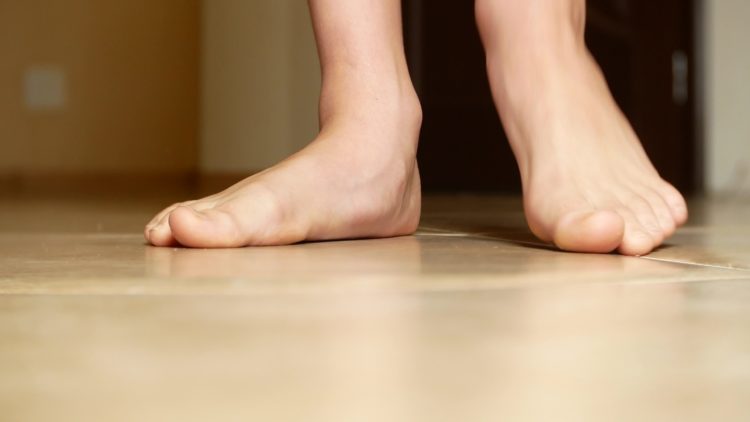
When understanding the condition of flatfoot in children, it is important to recognize the differences between the two types of flatfoot; flexible and rigid. The two types of flatfoot are very different from one another and require different treatment plans that can include both nonsurgical and surgical options. Because flatfoot is typically the normal foot shape in infants, physicians will wait to diagnose a child with flatfoot until they have developed past the age of two years old.
Flexible Flatfoot
Within the first decade of a child’s life, the arch of the foot develops along with the bones, muscles, and ligaments within the foot. In flexible flatfoot, the arch is present when the foot is not bearing any weight, but disappears when standing or walking. Infants are typically born with flexible flat feet, but the condition usually resolves by age ten. In preschool children aged three to six years, studies have shown that higher joint laxity (loose ligaments), W-sitting (a child sitting on their bottom with both knees bent and their legs turned out away from their body), male gender, obesity, and younger age can all be associated with a higher risk of having flatfoot. In some patients, flexible flatfoot will continue into adolescence and adulthood.
Symptoms of Flexible Flatfoot
When flat fleet become symptomatic, patients can experience persistent and debilitating pain that can limit participation in sports, recreation, and enjoyment of every-daily activities. In the case of symptomatic flexible flatfoot, it is recommended to see an orthopedic specialist. If the child is showing no symptoms, evidence suggests that treatment is typically unnecessary, and simply observing the child is suitable.
Examination and Treatment for Flexible Flatfoot
When a child or adolescent is being seen for flatfoot, the physical examination starts with a generalized musculoskeletal examination. Examination will most likely include inspection of the feet in both the standing and sitting positions and while walking. The physician should also examine the feet from the front and the rear while the patient stands.
The decision to simply observe versus treat a child with flexible flat feet is based on the patient’s symptoms and what the physician finds during the exam. For patients with pain-free, flexible flat feet, there is no concrete evidence that any available intervention can alter the natural course of foot shape development. Observation is generally the best course of treatment. Referral to a pediatric orthopedist is encouraged for patients with pain, fatigue, or concerns regarding malalignment. Treatment options for symptomatic patients include physical therapy, shoe wear modification, orthotics, and, occasionally, surgery.
Rigid Flatfoot
Rigid flatfoot, on the other hand, is less common and is a more serious condition that requires medical attention. It is characterized by a fixed flatfoot with no visible arch, even when the child is on tiptoes. Rigid flatfoot can cause pain, stiffness, and difficulty walking, and may require the use of orthotics or other treatments to correct the condition.
Treatment for Rigid flatfoot
Rigid flatfoot is often associated with abnormal foot development caused by a more serious underlying pathology, such as a neuromuscular condition. The vast majority of patients with neuromuscular flatfoot will have rigid flatfoot. Management of neuromuscular flatfoot differs from management of idiopathic flexible flatfoot because it often requires more invasive treatment, such as surgery.
The treatment for rigid flatfoot in children depends on the severity of the condition and the age of the child. In mild cases, orthotic shoe inserts or arch supports may be recommended to provide support and correct the foot’s alignment. Physical therapy exercises may also be prescribed to improve the strength and flexibility of the foot muscles. In more severe cases, surgery may be necessary to correct the alignment of the foot bones and restore the arch. Recovery from surgery may take several months, and physical therapy may be necessary to regain strength and mobility.
Pediatric orthopedic surgeon, Dr. Justin Roth, discusses the treatment of flatfoot in this quick video:
Video Transcript:
“The vast majority of flat feet need nothing, they don’t need to be fixed. Flat feet need a little bit of therapy, particularly for stretching. Most flat feet, as your heel kicks out laterally, get a tighter heel cord or your Achilles in the back gets tight, and that’s what causes the majority of pain in patients with flat feet.
Greater than 95% of patients with flat feet do not need surgery. As you get older, it becomes harder to undergo a reconstructive procedure, and that involves being off your feet for six weeks to three months, and then going through rehabilitation, which takes another couple of months. Oftentimes it’s a bilateral problem, so getting surgery on both sides.
I think the optimal time, if you’re going to fix a flat foot, is about 13 to 15 years old.”
For more tips and information on living a healthy and pain-free life, join our monthly newsletter. The link to sign up is below.





